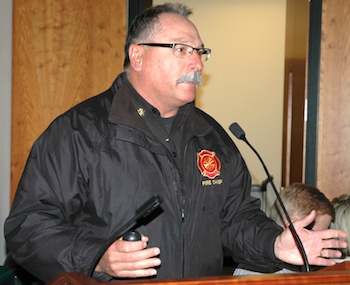ARLINGTON — The city’s public safety director told the City Council March 7 that the Arlington Fire Department’s Emergency Medical Services expenses should be covered by a combination of sources.
Bruce Stedman said EMS levies, contracts with partner fire districts, transportation fees and payments from the airport for services should all pay the balance.
Only they don’t.
“This is something that fire service agencies are going through in the whole state,” said Stedman, who reported that such agencies have lobbied the state legislature to increase the EMS levy rate ceiling from 50 to 75 cents per $1,000 of assessed property value.
EMS service costs have historically exceeded EMS revenues, so the city’s general fund has subsidized that deficit. A combination of the general fund and airport payments already cover the department’s fire service.
When councilman Mike Hopson asked why EMS transitioned from the hospital to the fire department, Stedman and city administrator Paul Ellis conceded that decision was made before their time.
But Greg Koontz, president of the local firefighters’ union, pointed out that every hospital-based EMS in Snohomish County got out of doing business at hospitals from 1994-99.
Prior to the council’s March 12 retreat to discuss the sustainability of fire and EMS funding, Stedman reviewed the state of affairs for the council and public, including alternatives the city has explored and found to be dead ends.
Stedman noted that sales tax collections have improved steadily since 2010, but have yet to reach their pre-recession levels of 2007.
When the city commissioned a study by Emergency Services Consulting International in 2013, only seven of the 15 fire and EMS agencies that were invited participated.
The study found that a limited amount of cost savings could be realized by forming a regional fire authority with Silvana Fire District 19 and Arlington Heights Fire District 21, by eliminating redundant administration between, but the two districts decided against it.
“We would have needed to consolidate the agencies very slowly, and it wouldn’t have saved that much money,” Stedman said.
In 2015, a sustainability committee met to produce four recommendations.
“What was great about that committee was that it had so many participants,” Stedman said, citing the presence of City Council and staff, as well as all levels of the police and fire departments, including volunteers, careerists, managers and union reps. “This gave us a global view of the situation.”
The committee was tasked with examining funding, determining acceptable levels of service for service providers and receivers, and recommending steps that were specific, sustainable and actionable.
The committee recommended that Arlington look into cooperating with the Marysville Fire District, retain a third party to evaluate its services and costs, weigh the costs and benefits of the volunteer firefighter program, and develop and implement a community awareness campaign.
Stedman touted the effectiveness of the “All-In” campaign, even as he acknowledged some of its gaps, while alluding to changes that have been made to the volunteer program.
The city hired FCS to conduct its third-party study, but Stedman was able to confirm that a more concrete partnership with Marysville is unlikely.
“Marysville’s dealing with its own issues right now, so there’s not a big interest from them in moving forward with these sorts of plans,” Stedman said.
The council retreat will run from 8.a.m. to 3 p.m. Saturday, March 12, in council chambers at 110 E. Third St.







